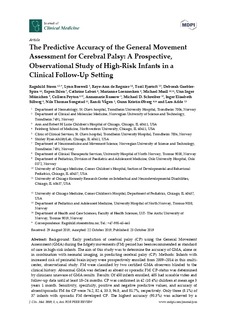| dc.contributor.author | Støen, Ragnhild | |
| dc.contributor.author | Boswell, Lynn | |
| dc.contributor.author | De Regnier, Raye-Ann | |
| dc.contributor.author | Fjørtoft, Toril Larsson | |
| dc.contributor.author | Gaebler-Spira, Deborah | |
| dc.contributor.author | Ihlen, Espen Alexander F. | |
| dc.contributor.author | Labori, Cathrine | |
| dc.contributor.author | Loennecken, Marianne | |
| dc.contributor.author | Msall, Michael E. | |
| dc.contributor.author | Moinichen, Unn Inger | |
| dc.contributor.author | Peyton, Colleen | |
| dc.contributor.author | Russow, Annamarie | |
| dc.contributor.author | Schreiber, Michael D. | |
| dc.contributor.author | Silberg, Inger Elisabeth | |
| dc.contributor.author | Songstad, Nils Thomas | |
| dc.contributor.author | Vågen, Randi Tynes | |
| dc.contributor.author | Øberg, Gunn Kristin | |
| dc.contributor.author | Adde, Lars | |
| dc.date.accessioned | 2019-11-22T08:42:21Z | |
| dc.date.available | 2019-11-22T08:42:21Z | |
| dc.date.created | 2019-10-26T13:10:29Z | |
| dc.date.issued | 2019 | |
| dc.identifier.issn | 2077-0383 | |
| dc.identifier.uri | http://hdl.handle.net/11250/2629977 | |
| dc.description.abstract | Background: Early prediction of cerebral palsy (CP) using the General Movement Assessment (GMA) during the fidgety movements (FM) period has been recommended as standard of care in high-risk infants. The aim of this study was to determine the accuracy of GMA, alone or in combination with neonatal imaging, in predicting cerebral palsy (CP). Methods: Infants with increased risk of perinatal brain injury were prospectively enrolled from 2009–2014 in this multi-center, observational study. FM were classified by two certified GMA observers blinded to the clinical history. Abnormal GMA was defined as absent or sporadic FM. CP-status was determined by clinicians unaware of GMA results. Results: Of 450 infants enrolled, 405 had scorable video and follow-up data until at least 18–24 months. CP was confirmed in 42 (10.4%) children at mean age 3 years 1 month. Sensitivity, specificity, positive and negative predictive values, and accuracy of absent/sporadic FM for CP were 76.2, 82.4, 33.3, 96.8, and 81.7%, respectively. Only three (8.1%) of 37 infants with sporadic FM developed CP. The highest accuracy (95.3%) was achieved by a combination of absent FM and abnormal neonatal imaging. Conclusion: In infants with a broad range of neonatal risk factors, accuracy of early CP prediction was lower for GMA than previously reported but increased when combined with neonatal imaging. Sporadic FM did not predict CP in this study. | nb_NO |
| dc.language.iso | eng | nb_NO |
| dc.publisher | MDPI | nb_NO |
| dc.rights | Navngivelse 4.0 Internasjonal | * |
| dc.rights.uri | http://creativecommons.org/licenses/by/4.0/deed.no | * |
| dc.title | The Predictive Accuracy of the General Movement Assessment for Cerebral Palsy: A Prospective, Observational Study of High-Risk Infants in a Clinical Follow-Up Setting | nb_NO |
| dc.type | Journal article | nb_NO |
| dc.type | Peer reviewed | nb_NO |
| dc.description.version | publishedVersion | nb_NO |
| dc.source.volume | 8 | nb_NO |
| dc.source.journal | Journal of Clinical Medicine | nb_NO |
| dc.identifier.doi | 10.3390/jcm8111790 | |
| dc.identifier.cristin | 1740799 | |
| dc.description.localcode | © 2019 by the authors. Submitted for possible open access publication under the terms and conditions of the Creative Commons Attribution (CC BY) license (http://creativecommons.org/licenses/by/4.0/). | nb_NO |
| cristin.unitcode | 194,65,15,0 | |
| cristin.unitcode | 1920,7,0,0 | |
| cristin.unitcode | 194,65,30,0 | |
| cristin.unitname | Institutt for klinisk og molekylær medisin | |
| cristin.unitname | Klinikk for kliniske servicefunksjoner | |
| cristin.unitname | Institutt for nevromedisin og bevegelsesvitenskap | |
| cristin.ispublished | true | |
| cristin.fulltext | postprint | |
| cristin.qualitycode | 1 | |

